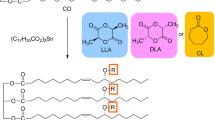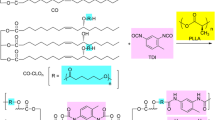Abstract
Urethanization of castor oil (CO), β-cyclodextrin (CD), and 1-adamantanol (AdOH) with hexamethylene diisocyanate (HDI) at a CD/AdOH molar ratio of 1:1 and various feed CO fractions produced castor oil-based polyurethane network films (CAPUs) incorporating cyclodextrin and adamantane units as host and guest components, respectively. For comparison, similar urethanization reactions were performed with CO/CD/HDI and CO/AdOH/HDI to produce network films that lacked guest or host moieties (CDPU and ADPU, respectively). The results of Fourier transform infrared spectroscopy and gel fraction measurements confirmed the formation of polyurethane networks. The glass transition temperatures, tensile strengths, and tensile moduli of the network films increased with decreasing CO fractions. All CAPU films demonstrated healing properties at room temperature; however, the CDPU and ADPU films did not. The healing efficiency also increased with decreasing CO fraction.













Similar content being viewed by others
References
Aguirresarobe RH, Nevejans S, Reck B, Irusta L, Sardon H, Asua JM, Ballard N (2021) Healable and self-healing polyurethanes using dynamic chemistry. Prog Polym Sci 114:101362. https://doi.org/10.1016/j.progpolymsci.2021.101362
Lee WJ, Oh HG, Cha SH (2021) A brief review of self-healing polyurethane based on dynamic chemistry. Macromol Res 29:649–664. https://doi.org/10.1007/s13233-021-9088-2
Willocq B, Odent J, Dubois R, Raquez PMJ (2020) Advances in intrinsic self-healing polyurethanes and related composites. RSC Adv 10:13766–13782. https://doi.org/10.1039/d0ra01394c
Wang S, Liu Q, Li L, Urban MW (2021) Recent advances in stimuli-responsive commodity polymers. Macromol Rapid Commun 42:2100054. https://doi.org/10.1002/marc.202100054
Nakahata M, Takashima Y, Yamaguchi H, Harada A (2011) Redox-responsive self-healing materials formed from host−guest polymers. Nature Commun 2:511–516. https://doi.org/10.1038/ncomms1521
Kakuta T, Takashima Y, Harada A (2013) Highly elastic supramolecular hydrogels using host−guest inclusion complexes with cyclodextrins. Macromolecules 46:4575–5479. https://doi.org/10.1021/ma400695p
Xiong H, Li Y, Ye H, Huang G, Zhou D, Huang Y (2020) Self-healing supramolecular hydrogels through host–guest interaction between cyclodextrin and carborane. J Mater Chem B 8:10309–10313. https://doi.org/10.1039/d0tb01886d
Sugane K, Shibata M (2021) Self-healing thermoset polyurethanes utilizing host-guest interaction of cyclodextrin and adamantane. Polymer 221:123629. https://doi.org/10.1016/j.polymer.2021.123629
Hai TAP, Tessman M, Neelakantan N, Samoylov AA, Ito Y, Rajput BS, Pourahmady N, Burkart MD (2021) Renewable polyurethanes from sustainable biological precursors. Biomacromolecules 22:1770–1792. https://doi.org/10.1021/acs.biomac.0c01610
Noreen A, Zia KM, Zuber M, Tabasum S, Zahoor AF (2016) Bio-based polyurethane: an efficient and environment friendly coating systems: a review. Prog Org Coat 91:25–32. https://doi.org/10.1016/j.porgcoat.2015.11.018
Teramoto N, Saitoh Y, Takahashi A, Shibata M (2010) Biodegradable polyurethane elastomers prepared from isocyanate-terminated poly(ethylene adipate), castor oil, and glycerol. J Appl Polym Sci 115:3199–3204. https://doi.org/10.1002/app.30019
Trovatin G, Suman MVN, Sanches EA, Campelo PH, Neto RB, Neto SC, Trovati LR (2019) Production and characterization of polyurethane castor oil (Ricinus communis) foam for nautical fender. Polym Test 73:87–93. https://doi.org/10.1016/j.polymertesting.2018.11.010
Lee JH, Kim SH, Oh KW (2021) Bio-based polyurethane foams with castor oil based multifunctional polyols for improved compressive properties. Polymers 13:576. https://doi.org/10.3390/polym13040576
Morales-Cerrada R, Tavernier R, Caillol S (2021) Fully bio-based thermosetting polyurethanes from bio-based polyols and isocyanates. Polymers 13:1255. https://doi.org/10.3390/polym13081255
Wang B, MA S, Xu X, Li Q, Yu T, Wang S, Yan S, Liu Y, Zhu J (2020) High-performance, biobased, degradable polyurethane thermoset and its application in readily recyclable carbon fiber composites. ACS Sustain Chem Eng 8:11162–11170. https://doi.org/10.1021/acssuschemeng.0c02330
Haro JC, Allegretti C, Smit AT, Turri S, D’Arrigo P, Griffini G (2019) Biobased polyurethane ccoatings with high biomass content: tailored properties by lignin selection. ACS Sustain Chem Eng 7:11700–11711. https://doi.org/10.1021/acssuschemeng.9b01873
Matsuda S, Shibita A, Shimasaki T, Teramoto N, Shibata M (2018) Toughening modification of polyester–urethane networks incorporating oligolactide and oligocaprolactone segments by utilizing castor oil as a core molecule. Polym Bull 76:5313–5332. https://doi.org/10.1007/s00289-018-2656-8
Acknowledgements
The authors would like to thank Chiba Institute of Technology for the opportunity to bring this work to life.
Author information
Authors and Affiliations
Corresponding author
Ethics declarations
Competing interest
The authors declare that they have no known competing financial interests or personal relationships that could have appeared to influence the work reported in this paper.
Additional information
Publisher's Note
Springer Nature remains neutral with regard to jurisdictional claims in published maps and institutional affiliations.
Supplementary Information
Below is the link to the electronic supplementary material.
Rights and permissions
Springer Nature or its licensor (e.g. a society or other partner) holds exclusive rights to this article under a publishing agreement with the author(s) or other rightsholder(s); author self-archiving of the accepted manuscript version of this article is solely governed by the terms of such publishing agreement and applicable law.
About this article
Cite this article
Sekiya, T., Shibata, M. Self-healing castor oil-based polyurethane networks featuring cyclodextrin–adamantane host–guest interactions. Polym. Bull. 80, 10125–10138 (2023). https://doi.org/10.1007/s00289-022-04555-x
Received:
Revised:
Accepted:
Published:
Issue Date:
DOI: https://doi.org/10.1007/s00289-022-04555-x




